Ever wonder as you’re sitting in that window seat and looking out at the engine hanging under the wing just exactly how does it work?
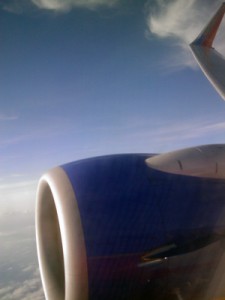
I’d be willing to bet your extra bag of peanuts you scored from the flight attendant that a lot of folks don’t know exactly how it works. (most don’t even know how a car’s engine works either just that it takes gas) No problem. It can easily be explained with four simple terms that you’ll never forget.
“Suck”, “Squeeze”, “Bang” and “Blow”
No this isn’t some sort of dirty joke, but rather the simple terms used to describe the cycle of an internal combustion engine. This cycle is the same whether you’re talking about the engine in your automobile or in an airplane. There are 4 stages:
Intake (Suck) – Air is smoothed and introduced in a controlled manner
Compression (Squeeze) – The Air is compressed which increases the heat and pressure.
Combustion (Bang) – The compressed air is mixed with atomized fuel which causes the mixture to burn; the pressure and temperature both increase as does the velocity of the gases.
Exhaust (Blow) – Kinetic energy from the high energy exhaust gases push past the turbine blades which converts the kinetic energy into torque and transmitted through the internal shaft to the fan blades in the compressor in order to repeat the cycle, then the gases are purged. (in a car the force is exerted on the piston transmitting torque back to the crankshaft making it turn)
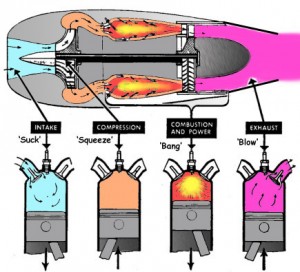
Combustion cycle of a jet engine compared to car engine
Each cylinder in your car does these in sequence with the other cylinders to remain balanced. In a jet engine, the process after initial start-up is all simultaneous. That actually makes a jet engine significantly more efficient than a 4 stroke automobile engine. So without going into too much detail, its important to understand the differences in jet engine types. There are in fact 4 major types:
- turbojet – the original design, fast, high energy, the least economic. Not commonly used much except in older business jets and fighter aircraft like the F-4 Phantom.
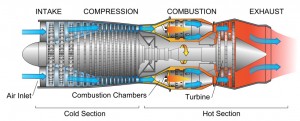
turbojet
- turboprop – a small, high torque jet engine. Majority of energy produced is converted into torque to turn large propeller blades which produce the majority of the thrust. These are commonly used in regional commuter aircraft as well as large cargo aircraft like the C-130 Hercules.
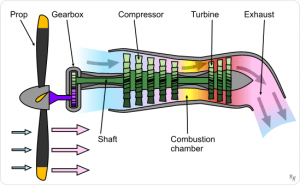
turboprop
- turboshaft – a small, extremely high torque jet engine similar to a turboprop, but instead of connecting to a prop, it is connected to a main shaft and its torque is converted through a main transmission into energy to rotate a helicopter’s rotor assembly. These are used in helicopters like the SH-60 Seahawk/UH-60 Blackhawk.
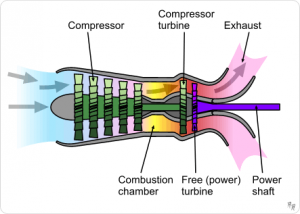
turboshaft
- turbofan – a highly efficient design; almost like building an engine casing around a turboprop engine. Lower noise, smaller size than a turboprop and very reliable. These are the most commonly used engines today and are installed in everything from large commercial passenger aircraft to modern fighter jets like the F/A-18E.
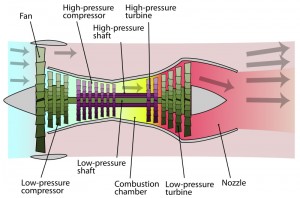
turbofan
Turbofan engines are the most commonly used jet engine in the world. Their failure rates are extremely low as are their maintenance requirements.
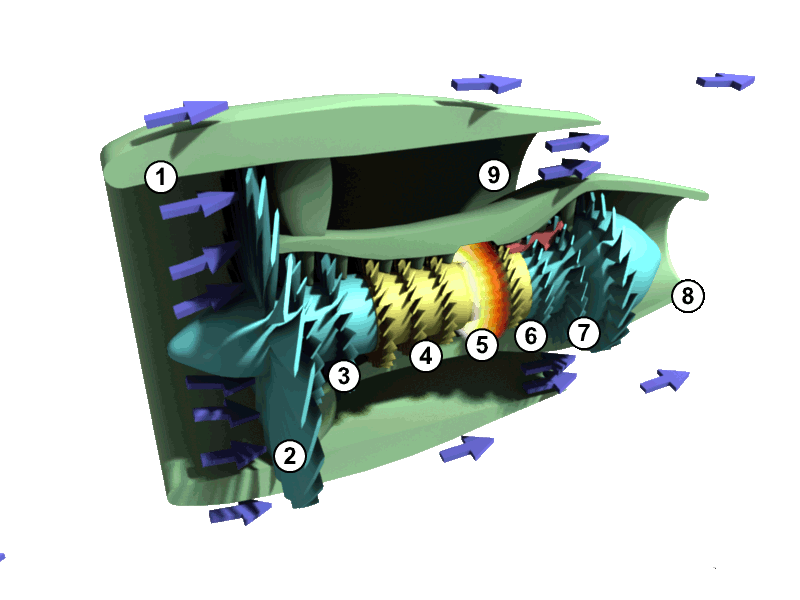
Animation showing the combustion cycle in a turbofan engine
-
Parts of a typical high-bypass turbofan engine
1. Engine Nacelle
2. Fan (N1)
3. Low pressure compressor (N1)
4. High pressure compressor (N2) *bleed air comes from the stages in this area*
5. Combustion chamber
6. High pressure turbine
7. Low pressure turbine
8. Core nozzle (exhaust cone)
9. Fan by-pass nozzle (thrust reverser components mounted in this area)
Above you see an animation of the combustion process of a high-bypass turbofan engine. This type of design is extremely efficient, and the majority of the thrust is not created in the center main section but rather from the by-pass area. Almost 80% in fact. (Thanks to Mr. Bernoulli!) In fact a high-bypass, turbofan engine like the CFM56-7 engine used in the C-40/737-700, is statistically less likely to have a mechanical failure (resulting in shutdown).
“The CFM56-7 also has one of the lowest in-flight shutdown rates in the industry: .002 per 1,000 hours. The rate is equivalent to one engine-caused in-flight shutdown every 500,000 flight hours. On a statistical basis, with a typical annual 737 utilization of about 3,000 hours, this rate would equate to one in-flight shutdown event every 165 years.” – CFM International
So now they next time you’re on-board that 737 on your way to a wonderful vacation, you can look at the wing with a knowing smile. Or perhaps strike up a conversation with your travel companions and place a wager for their bag of peanuts that you explain how jet engines work in 4, single syllable words.
